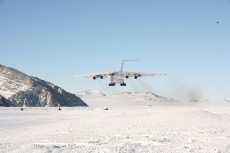Big bird
Ilyushin il-76 was the Soviet Union’s version of Lockheed’s C-130 Hercules, but is considerably larger. The Soviet Air Force started using the plane in June 1974 and il-76 became the main strategic air-freighter east of the Iron Curtain.
 Ilyushin il-76 landing on Union Glacier. Photo: Steve Jones / Antarctic Logistics and Expeditions Ilyushin il-76 landing on Union Glacier. Photo: Steve Jones / Antarctic Logistics and Expeditions
This huge bird was designed to carry a payload of 40 tonnes. During the war in Afghanistan (1979-1991) il-76 aircraft transported 786 000 people and 315 800 tonnes of supplies.
Nowadays other countries, including China, also fly this aircraft. It is still used for various transport missions during demanding field operations in war zones, but is increasingly being put to civilian use to meet challenges posed by natural disasters and for relief work. The plane is robust and can land without a proper runway – an all-terrain vehicle of the sky.
Our crew is from Russia. They are highly experienced and have flown to and from Antarctica over several summer seasons. The flying time from Punta Arenas to Union Glacier in Antarctica is just under four hours. That means the flight has no “point of no return” beyond which a dwindling fuel supply forces the crew to fly onward regardless of weather conditions at their destination. The short flight increases our safety margin – and that is perfectly okay with us.
Our gear has been loaded onto the plane. On Friday evening, a Twin Otter and a Basler BT-67 (a modification of the more famous DC-3) arrived at Union Glacier, where will soon land. People are working hard clearing the runway, preparing it to receive our big bird. We may arrive on Monday, or we may not. It all depends on weather and wind in the world’s coldest, highest, windiest, driest and most desolate continent.
|